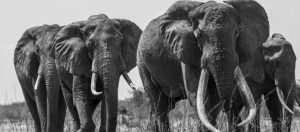
We couldn’t find him anywhere. We had circled all of the watering holes where Satao, one of the biggest remaining Tuskers in Tsavo, Kenya, spent most of his time. Richard Moller was up front in his Supercub patrol aircraft, shaking his head. As Chief Conservation Officer of the Tsavo Trust, Richard has been spending well over 30 hours every month in the air conducting patrols over this huge, largely roadless wilderness. His focus – and one of the reasons why Save the Elephants has funded this Air Wing since its inception – is on keeping an eye on these magnificent bulls. No-one knows their haunts and habits better, so where was he? This was back in March this year, and I was down in Tsavo for the opening of a new research centre for STE’s Elephants and Bees Project, run by Dr Lucy King. I wanted to get a better feel for the challenges that Richard was facing every day, so I took the back seat usually occupied by the Kenya Wildlife Service ranger that accompanies his patrols. As we flew we passed over scores of elephants that were scattered across the open landscape, some with large ivory, but Richard barely had to glance to know they weren’t Satao. “There’s only one more place he could be,” Richard said, and pointed the aircraft on a new heading. Five minutes later, with only a glint of a waterhole visible in the distance, I saw his shoulders relax. “There he is,” he said. Much has been written about Satao’s magnificence. To me he looked startlingly impressive. I felt as though I was looking at an animal transplanted from another era, a time when mammoths still crashed across the frozen north. The sentiment shocked me, then turned became an inspiration. He and his kind have to survive – we simply can’t let such natural wonders disappear for ever. As we circled above a couple of times, the true significance of an icon began to sink into my mind. Two months later Richard told me that he was once again searching for Satao but that this time he had a bad feeling. He’d spotted the carcass of a big bull, killed by a poisoned arrow and tusks hacked out. From the ears and other features looked like Satao. The location fitted. But he and the Kenya Wildlife Service didn’t want to announce such news until they were absolutely sure, so for days they kept searching. Maybe, just maybe, he still lived. But no. More than a week later, they finally let the world know. Fittingly, the news soon spread across the entire world: East, West, North and South. Back in Tsavo the Kenya Wildlife Service and Moller’s team hadn’t been idle. On 22nd June it was reported that three of the men responsible for Satao’s death had been arrested by KWS. Save the Elephants & the Tsavo Trust then donated a new Toyota Landcruiser fitted out for anti poaching work, funded by the STE / WCN Elephant Crisis Fund. KWS have dedicated the vehicle to large elephant protection, making it a perfect compliment to the Tsavo Trust’s aerial support. If Satao’s fellow great tuskers are to remain in the world to astonish more people, to leave them wide-eyed and make them feel the span of eras, then we must do more. We have great plans that are already being implemented; new initiatives to reduce demand for ivory, helping authorities crack down on trafficking networks, and of course tightening the essential web of security on the ground. As always, none of this would be possible without the donations that fund the work of Save the Elephants, and of our partner organisations. Our heartfelt thanks to all those that have lent their support. And for those who want to get involved, please remember that donations given through the Elephant Crisis Fund are matched to double their impact, and 100% reach the project itself.

